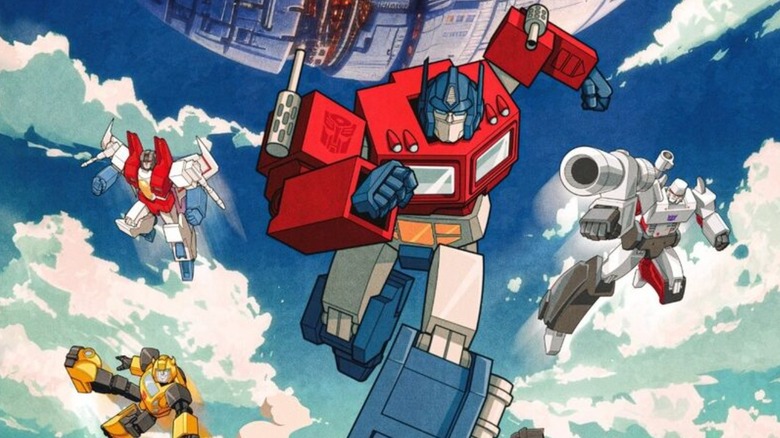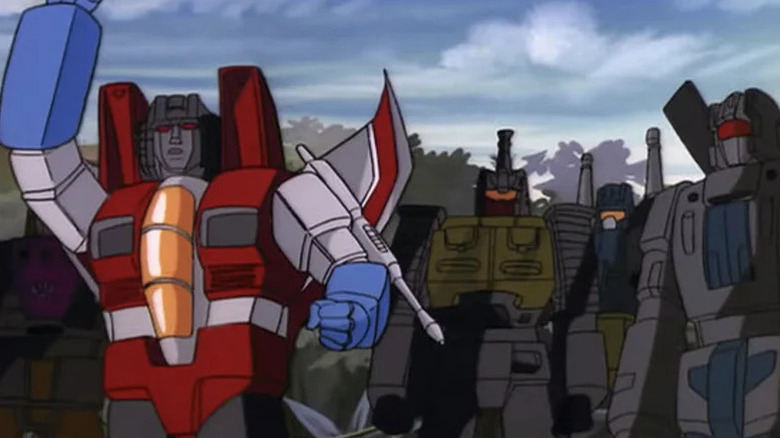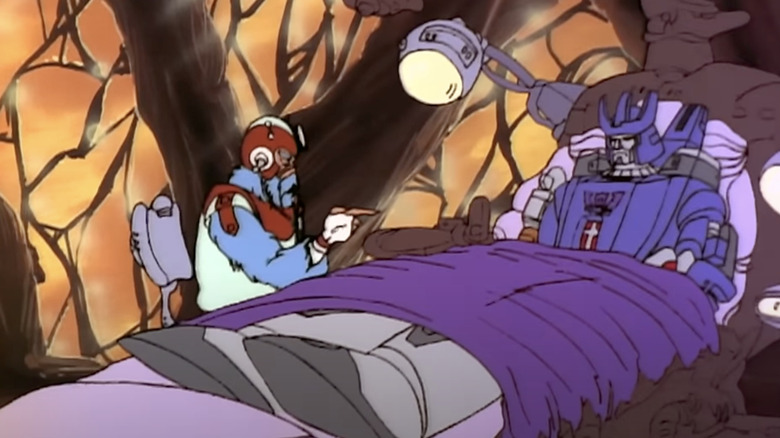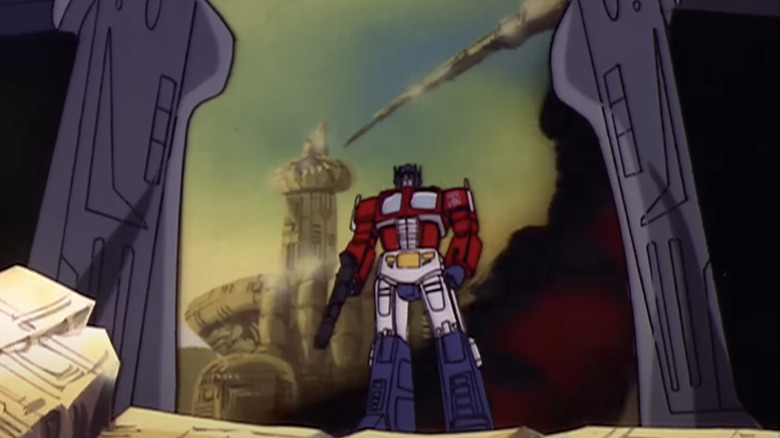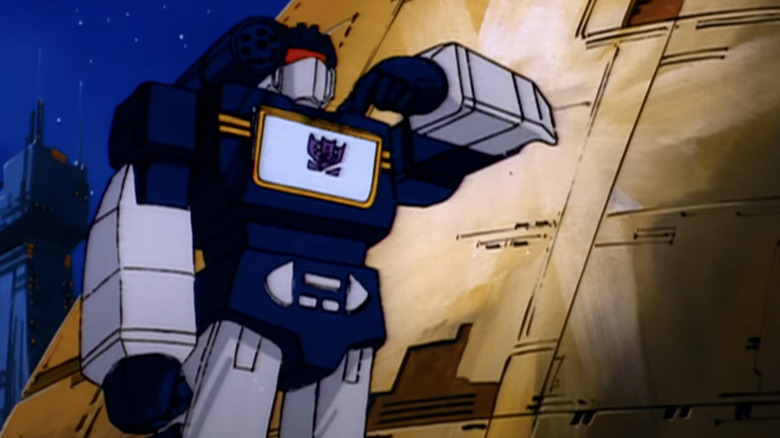The 5 Best Episodes Of The Original 80s Transformers Cartoon, Ranked
We may receive a commission on purchases made from links.
The 1980s were a sea change for children's television, as the era's deregulatory practices even trickled down to cartoons. During this decade, the Federal Communications Commission (FCC) took a more lax attitude to limiting advertisements in children's TV. Since then, there have been plenty of cartoons that are toy commercials first and foremost, with one of the premier and longest lasting examples being that of "The Transformers."
In-universe, these shapeshifting robots came from the planet Cybertron. The conflict between the heroic Autobots and evil Decepticons had drained their world of all its resources, so they came to Earth to find new fuel for their war. In reality, the Transformers were a collection of mecha toys that Hasbro had imported from Japan and rebranded under a single toy line. Marvel Comics editors/writers Jim Shooter, Dennis O'Neil, and Bob Budiansky then cooked up a story about these toys, which became a comic (published by Marvel) and a cartoon (produced by Sunbow Entertainment).
Of all the '80s toy-based cartoons, "The Transformers" has the greatest pop culture legacy. Kids are still playing with "Transformers" toys today, but you can't say the same about "The Inhumanoids." The series was even spun-off as a (surprisingly dark) animated movie in 1986, presaging "Transformers" becoming a live-action blockbuster in 2007.
Now, "The Transformers" is not high art — literally, as each and every episode is filled with coloring and animation errors. But something about the cartoon, be it the premise that invited kids' imagination or the striking voice acting and character designs, made it stand out. Do any of the stories the series told still hold up?
5. Starscream's Brigade
Traitorous Decepticon Air Commander Starscream is the best "Transformers" character. I'm not saying he has to be your favorite, but Starscream is easily the franchise's most dynamic and engaging character. He's got a simple goal: overthrow Megatron and become the new leader of the Decepticons. Watching him try (and fail) to do so never stops being entertaining.
His greatest attempt in "The Transformers" comes late in season 2 in the episode "Starscream's Brigade." There, writer Michael Charles Hill cooks up a pretty neat way to showcase the new Combaticon toys. In this storyline, Megatron (Frank Welker) exiles Starscream (Christopher Collins) from the Decepticons, so Starscream decides he's going to create his own army. The results show just how badly his ambition outstrips his reach.
The episode still has its flaws, in particular an anticlimactic ending where the Combaticons' combined form, Bruticus (Roger C. Carmel), gets sucker-punched by fellow giant Menasor (first Carmel, later Regis Cordic). But it also stands out as one of the most formula breaking episodes of "The Transformers" seasons 1 and 2.
Prior to the movie, "The Transformers" kept a strict status quo. Optimus Prime (Peter Cullen) led the Autobots, Megatron led the Decepticons, and that was that. Starscream, meanwhile, was often more comic relief than a legitimate rival to Megatron. Compare this to the contemporary "Transformers" comic books, where Decepticon leadership often changes hands due to internal power struggles. In depicting a true Decepticon civil war, "Starscream's Brigade" stands out. It's little surprise it remains an influential storyline in the "Transformers" franchise to this day.
4. Webworld
In "The Transformers: The Movie," Megatron was rebuilt by the monstrous Unicron (Orson Welles) into a new form. The remade Galvatron (Leonard Nimoy in the movie, Welker again in the show) was even stronger than Megatron, but utterly erratic. Megatron's sneering and scheming was replaced by raving, and he attacked his own troops as much as he did the Autobots.
Halfway through the third season of "The Transformers," the Decepticons are fed up with their new and not so improved leader. So, in the episode "Webworld (co-written by Wolverine creator Len Wein), Galvatron's faithful second-in-command, Cyclonus (Carmel), reluctantly decides to have his leader institutionalized.
Cyclonus tricks Galvatron into visiting the world of Torkulon, an enormous planet-sized asylum where prisoners are kept bound by webs. The natives bust out everything therapeutic trick in the book to try and heal Galvatron, but to no avail. In the end, his wayward mind is simply too much for the planet to take. Galvatron's therapy montage doesn't last nearly long enough, but it leads to some of the funniest moments in the show.
"The Transformers" was often unintentionally funny, due to the rushed and sloppy craftsmanship and/or the simple silliness that many of its writers reveled in. "Webworld," however, is purposefully funny. As far as psychiatry satire goes, it's hardly "One Flew Over The Cuckoo's Nest," but it's still a bar above most other "Transformers" episodes.
3. War Dawn
Season 2 of "The Transformers" is when the series starts to probe into the history of Cybertron and the Transformers, setting up a relatively consistent mythology (as opposed to earlier episodes, which play things by ear).
Two-parter "The Key To Vector Sigma" establishes that at the core of Cybertron lies a central computer (the titular Vector Sigma) that bestows each Transformer with life. "Before Cybertron was, I was," the ancient intelligence declares, paving the way for later shows to establish the concept of "Sparks" or Transformers' souls.
In "Vector Sigma," the Autobots create a five-bot team called the Aerialbots to counter the Decepticons' air advantage. But the Aerialbots are taken with the Decepticons and, in "War Dawn," they almost defect ... until Megatron sends them back through time to nine million years in the past.
In Cybertron's Golden Age, the Aerialbots meet Orion Pax (Laurie Faso), a naive dockworker who admires the powerful Decepticons ... until Megatron attacks, mortally wounding Orion. The Aerialbots save him, though, allowing him to be rebuilt into a new, more powerful form: Optimus Prime. Optimus, and with him the Aerialbots, in turn end up learning a lesson about the dangers of admiring strength for strength's sake.
Essentially, all "Transformers" prequel stories go back to "War Dawn" in one way or another. The 2024 animated film "Transformers One" can practically be called a (loose) feature-length adaptation of the episode. "War Dawn" writer David Wise never intended to write such a momentous episode, but he wound up irrevocably shaping every "Transformers" project that followed.
2. Dark Awakening
Season 3 of "The Transformers" brings a third faction into the war for Cybertron: The Quintessons, a group of five-faced squid-like aliens who long ago created the Transformers as workers (the Autobots' ancestors) and soldiers (whose descendants are the Decepticons). Without a doubt, the Quintessons employ their most dastardly scheme in the episode "Dark Awakening."
In "The Transformers: The Movie," Optimus Prime perishes following a final battle with Megatron. That leaves an opening for young Autobot Hot Rod (Judd Nelson) to succeed him as Rodimus Prime (recast with Dick Gautier in the cartoon series). But Rodimus is plagued by self doubt, particularly in "Dark Awakening" when he literally meets the ghost of Optimus. The Quintessons have revived Optimus, you see, intending to use his half-alive, puppeted form to lead the Autobots to their doom. But as a final testament to his selflessness, Optimus overcomes their control and dies, once more, as a hero.
Some have called Optimus Prime's death in the movie one of the worst "Transformers" moments, but I think it's one of the best. Not because he's a bad character or the cartoon series benefitted from his absence, but because his demise is what elevated Optimus from an action figure into an icon. "Dark Awakening" understood the power of Prime's death, but it didn't exactly comfort kids who had been left heartbroken by Optimus' original demise. Thus, the "Transformers" season 3 finale was the two-parter "The Return of Optimus Prime" (for real this time). Even so, "Dark Awakening" stands as a more haunting, and yet no less powerful, episode.
1. More Than Meets The Eye
40 years of "Transformers" cartoons and it all goes back to the three-part pilot mini-series, "More Than Meets The Eye." Beginning millions of years ago on Cybertron, the episode's opening minutes follow the Autobots and Decepticons crash landing on Earth, laying dormant for millennia, and finally reawakening to resume their war on modern day Earth.
In a scant 60-ish minute runtime, "More Than Meets The Eye" gives each of its about two dozen characters a moment in the spotlight. Some of the characters who starred in the pilot would go on to anchor the actual series (Starscream, Soundwave, etc.) while others, not so much. For example, the Autobot Hound (Ken Sansom) is friends with the Autobots' human buddy Spike Witwicky (Corey Burton) in this pilot, but that role was usurped by Bumblebee (Dan Gilvezan) in later episodes.
Compared to the episodes that follow, the stakes feel higher. The show hadn't yet settled into a routine of "Decepticons try an evil scheme, Autobots stop it, and repeat," so the threat is more real. Indeed, the Decepticons spend most of the episodes winning, while the Autobots are the definitive underdogs. The robots' clash at the fictional Sherman Dam, featuring Optimus and Megatron going at it one on one, is a definitive highlight.
The greatest compliment I can give "More Than Meets The Eye" is this: I first saw it when I was 10 or so and had already seen the live-action "Transformers" movies. But instead of me gawking at how tame or hokey it looked in comparison, the cartoon still swept me off my feet. Since the beginning, there's been a spark (no pun intended) of magic beneath the commercialism of "Transformers" — you just have to be young at heart to find it.
"The Transformers" is streaming for free on Hasbro's YouTube channel.
